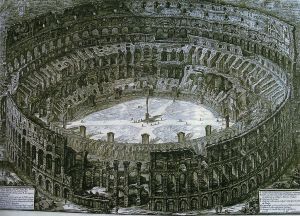In the twenty four hours since the announcement of the probable destruction of the temple of Baalshamin, which has stood in Palmyra since the reign of Tiberius, and near where the archaeologist Khaled al-Asaad was tortured and murdered this last month, thoughts of destruction have been much on my mind. It just so happens that today is the traditional date of the sack of Rome by the Visigoth Alaric I. Palaces, mausoleums and basilicas were destroyed, although not for ideological reasons.
Today is also the traditional anniversary of the eruption of Vesuvius in AD 79. Now, I am a Pliny the Elder fangirl, and it is a distressing quirk of history that the author of one of the defining artefacts of the early Roman Empire, a naval commander, military historian and orator, should be remembered for the manner of his death. Pliny the Younger, as we know, avoided his uncle’s fate because of a propensity for Greek homework. The eruption, which lasted for two days, buried the towns of Pompeii and Herculaneum, killing thousands of people. Though the site of Pompeii wasn’t discovered until the late 16th century, the eruption (‘grades Campaniae’, disaster at Campania) was known to medieval readers of Pliny’s Naturalis historia, because the vast majority of its manuscripts were prefaced by a mini-biography of the author, much as the standard text of Troilus and Criseyde begins ‘Geoffrey Chaucer was born in London’.
Destruction by nature and destruction by man cannot really be considered in the same register. Dresden in 1945 may in certain ways have resembled the shores of Aceh in late December 2004, loss of life is loss of life, but there can be no rationalisation, however unsatisfactory, for the freak natural disaster. It happens and everyone is equally powerless to prevent it. As Tewkesbury Abbey confirms, all we can do is not build on flood plains.
Where circumstances allow, i.e. not in Plymouth, Montserrat, humans will also rebuild. There was much admiration in 2011 for how quickly roads in Tōhoku were repaired after the extraordinary earthquake and tsunami, while the Franconian city of Würzburg, almost entirely destroyed in bombing raids in 1945, has been rebuilt in identical style, such that it is still recognisable from its depiction in Schedel’s 1493 Weltchronik. In cases where conquering forces have remained, there are even examples of the preservation of existing buildings, such as the requisitioning of pagan temples as Churches from the fourth to seventh centuries in Rome.
‘For thousands of years the Romans were the best in the world at… almost everything.’
Yet we as humans clearly have a desire to salt the fields, to ensure the complete destruction of an enemy’s way of life. The Harrowing of the North in 1069-70, England’s answer to the Fall of Carthage, is one method of delivering such destruction. The systematic obliteration of the Buddhas of Bamiyan, Sufi shrines in Mali, the remains of the palace of Ashurnasirpal II in Nimrud, to name but a few, is another. Gilgamesh and Enkidu destroy the Cedar Forest, Alexander razed Persepolis, the Christians of Alexandria burned the Serapeum and its library, and Marlowe’s Tamburlaine responds to his wife’s death as any dictator would:
This cursed town will I consume with fire
Because this place bereft me of my love.
The houses, burnt, will look as if they mourned,
And here will I set up her stature.
Such wanton destruction is inspired by a desire to cripple the enemy with the fear of one’s unwavering resolve. But, as has been much discussed in recent months, to destroy an enemy’s history is to remove every trace of their identity. In 2012, William Dalrymple wrote of the Umayyad mosque in Aleppo,
While the human pain inflicted by torture and killing is immeasurable, the destruction of a people’s heritage is irretrievable: once a monument is destroyed, it can never be replaced. With modern weaponry it only takes a few months of concerted shelling for the history of an entire people to be reduced to rubble. (The Guardian, 18.10.2012)
There is nothing that I can add that will sound any other than glib and half-hearted.
Perhaps, then, a message of hope: Saint Cuthbert was born in the early seventh century, and probably spent his entire life in Northumbria. Before the Conquest, he was arguably the most beloved of native English saints, even serving as a sort of Patron Saint of England, long before the concept existed, by merit of the devotion of the House of Wessex. He was buried at Lindisfarne, where he remained until it was sacked by Vikings in 875. Over the next two centuries, his body found rest at Chester-le-Street, Ripon and Durham, where in the early 12th century the Romanesque cathedral was constructed around his shrine. A very late Old English poem describes Cuthbert’s central role in the structure of the Cathedral:
Eardiæð æt ðem eadige is in ðem minstre
unarimeda reliquia,
ðær monia wundrum gewurðað, ðes ðe writ seggeð,
midd ðene Drihnes wer domes bideð.
[Inside the minster, by the blessed saint, are numberless relics; there many miracles occur, as books make known, while God’s servant lies there and waits for Judgement.]
The shrine was destroyed during the Reformation, and Cuthbert’s body buried elsewhere. Yet miraculously a copy of St John’s Gospel, which had been kept in his coffin perhaps since the early 8th century, survived. This book was recently purchased ‘for the nation’ for £9 million, and though officially attached to the British Library in London, has since been displayed in Durham, no more than a hundred yards from where it spent the better part of five hundred years.
There should be more stories like this.

